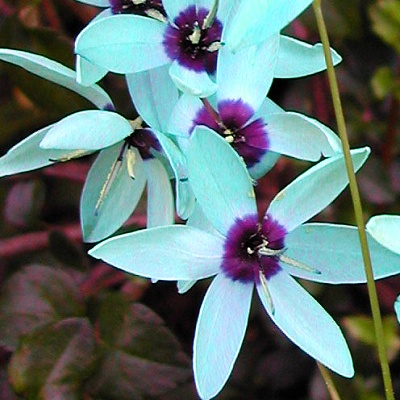Ixia viridiflora Germinating the seeds
When to plant -- Your seeds should be planted in autumn, around late September or early October in the Northern hemisphere. Until then, they should be stored in their envelope in a cool spot. Soil -- The soil should be well draining, to keep the bulbs from rotting. A typical mix is half potting soil and half perlite (use small- or medium-sized perlite, not large chunks) or coarse sand. An alternate mix is 2 parts perlite to 1 part coir fiber, with some granular fertilizer mixed in. If you use potting soil and it contains fertilizer, do not add additional fertilizer to your mix. Pot size - You may use a single pot for all the seeds, or smaller pots for 1-2 seeds. Either way, the pot should be about 6 inches tall (15 cm), and wide enough so that each seed is about 1½ inches (4 cm) from the next one, and 2 inches (5 cm) from the edge of the pot. The pot needs drainage holes. Avoid using a black pot, which absorb more heat in sun. Clay/ceramic pots are ideal to keep the roots cooler. Sowing -- Fill the pot to within 2 inches (5 cm) of the rim. Place the seeds about 1½ to 2 inches apart and cover with ¼ inch (4 mm) of soil. Add water so the soil is evenly moist, but not fully saturated. Place the pot in an area with good air circulation. The seeds sprout well between about 65 to 77° F (15-25°C), with cool nights. Avoid letting them get warmer than 80° F (27°C). I recommend placing a minimum/maximum thermometer near the pots, especially if using a heating mat. They should begin sprouting after about 4-6 weeks, but sometimes can take a bit longer. Sunlight -- Once your seeds sprout, move the pot to a sunny spot. They should be given a bright spot during the winter. In regions of strong, hot sun, some afternoon shade might be needed. Watering: Aim to keep the soil
evenly moist throughout the growing season. Avoid letting it dry out
completely, but also don't keep it constantly saturated. If you're unsure
if the soil has the proper moisture in the root zone, use a
moisture meter Feeding -- This species has relatively low fertilizer requirements. Feed about 2 weeks after they sprout, and again 2 months later. Use an all-purpose fertilizer that contains micronutrients. Avoid feeding them after early March (September in the Southern Hemisphere). Frost protection -- They don't mind cool conditions, but they must be protected from freezing temperatures. You may grow them indoors in a sunny room. Wind protection - The grass-like leaves and flower stems are somewhat fragile and may need protection or support in very strong winds. Dormancy care -- After the plant has flowered in Spring, the leaves will die back as the bulb prepares for dormancy. Reduce watering during this time, giving just enough water to keep the soil from becoming fully dry. The bulbs are at risk of rotting if the soil is too wet during this period. Once the leaves have completely died back, you may either leave them in their pot, or remove the bulbs and separate the baby corms (which are tiny and may be hard to find). Store any removed bulbs in a paper bag in a cool spot until autumn. If you leave them in their pot, ensure that the soil stays dry. Pests -- I've never noticed any insects on them, but mealy bugs are reported to like the bulbs, so if you notice cottony growth around the base of the stem, try using an insecticidal soap soil drench. Have fun growing them! - Jeff Strange Wonderful Things
|
|||||||||


